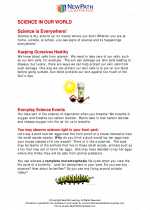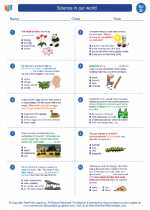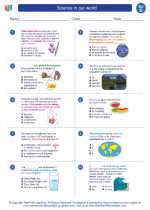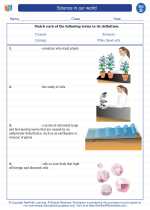Environment
The environment refers to the surroundings or conditions in which a person, animal, or plant lives or operates. It includes both natural and man-made elements and is essential for the well-being of all living organisms.
Components of the Environment
The environment can be divided into four main components:
- Atmosphere: The layer of gases that surround the Earth.
- Hydrosphere: All the water on the Earth, including oceans, rivers, lakes, and groundwater.
- Lithosphere: The solid outer part of the Earth, including the soil, rocks, and landforms.
- Biosphere: The regions of the surface, atmosphere, and hydrosphere of the Earth occupied by living organisms.
Importance of the Environment
The environment is vital for various reasons:
- It provides essential resources such as air, water, food, and shelter for living organisms.
- It maintains ecological balance and supports biodiversity.
- It plays a crucial role in climate regulation and weather patterns.
- It offers recreational and aesthetic benefits to humans.
Environmental Issues
There are several environmental issues that pose a threat to the well-being of the environment and living organisms:
- Climate Change: The long-term alteration of temperature and typical weather patterns in a place.
- Pollution: The introduction of harmful or poisonous substances into the environment.
- Deforestation: The clearing of forests for agriculture, urban development, or timber production.
- Loss of Biodiversity: The decline in the variety of living organisms in a particular habitat.
- Resource Depletion: The exhaustion of natural resources such as water, minerals, and fossil fuels.
Ways to Protect the Environment
It is crucial to take steps to preserve and protect the environment. Some effective measures include:
- Reducing, reusing, and recycling waste materials.
- Conserving water and energy by using them efficiently.
- Planting trees and participating in reforestation efforts.
- Supporting sustainable practices and minimizing the use of harmful chemicals.
- Spreading awareness and educating others about environmental conservation.
Conclusion
The environment is a complex and interconnected system that sustains life on Earth. It is essential for all living organisms, and efforts must be made to protect and preserve it for future generations.
.◂Science Worksheets and Study Guides Fourth Grade. Science in our world
Study Guide Science in our world - 4th gr.
Science in our world - 4th gr.  Worksheet/Answer key
Worksheet/Answer key Science in our world - 4th gr.
Science in our world - 4th gr.  Worksheet/Answer key
Worksheet/Answer key Science in our world - 4th gr.
Science in our world - 4th gr.  Worksheet/Answer key
Worksheet/Answer key Science in our world - 4th gr.
Science in our world - 4th gr.  Vocabulary/Answer key
Vocabulary/Answer key Science in our world - 4th gr.
Science in our world - 4th gr. 

 Worksheet/Answer key
Worksheet/Answer key
 Worksheet/Answer key
Worksheet/Answer key
 Worksheet/Answer key
Worksheet/Answer key
 Vocabulary/Answer key
Vocabulary/Answer key

The resources above cover the following skills:
History and Nature of Science: A student should understand the history and nature of science. A student who meets the content standard should:
Develop an understanding that historical perspectives of scientific explanations demonstrate that scientific knowledge changes over time, building on prior knowledge.
Develop an understanding that scientific knowledge is ongoing and subject to change as new evidence becomes available through experimental and/or observational confirmation(s).